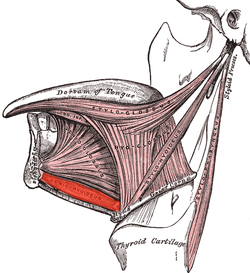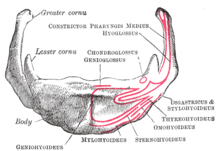Geniohyoid muscle
The geniohyoid muscle is a narrow muscle situated superior to the medial border of the mylohyoid muscle. It is named for its passage from the chin ("genio-" is a standard prefix for "chin")[1] to the hyoid bone.
| Geniohyoid muscle | |
|---|---|
Anterior view. Geniohyoid muscle labeled at upper center left | |
 Extrinsic muscles of the tongue. Left side. | |
| Details | |
| Origin | Inferior mental spine of mandible |
| Insertion | Hyoid bone |
| Artery | Branches of the lingual artery. |
| Nerve | C1 via the hypoglossal nerve |
| Actions | Carry hyoid bone and the tongue upward during deglutition |
| Identifiers | |
| Latin | Musculus geniohyoideus |
| TA | A04.2.03.007 |
| FMA | 46325 |
| Anatomical terms of muscle | |
Structure
It arises from the inferior mental spine, on the back of the mandibular symphysis, and runs backward and slightly downward, to be inserted into the anterior surface of the body of the hyoid bone.[2]:346 It lies in contact with its fellow of the opposite side. It thus belongs to the suprahyoid muscles. The muscle is supplied by branches of the lingual artery.
Innervation
The geniohyoid muscle is innervated by fibres from the first cervical nerve travelling alongside the hypoglossal nerve.[2][3][4] These fibers are called ansa cervicalis.
Variations
It may be blended with the one on opposite side or double; slips to greater cornu of hyoid bone and genioglossus occur.
Function
The geniohyoid muscle brings the hyoid bone forward and upwards.[2] This dilates the upper airway, assisting respiration.[3] During the first act of deglutition, when the mass of food is being driven from the mouth into the pharynx, the hyoid bone, and with it the tongue, is carried upward and forward by the anterior bellies of the Digastrici, the Mylohyoidei, and Geniohyoidei. It also assists in depressing the mandible
History
The inclined position of the geniohyoid muscle has been contrasted to the horizontal position in neanderthals.[5]
Additional images
 Hyoid bone. Anterior surface. Enlarged.
Hyoid bone. Anterior surface. Enlarged. Sagittal section of nose mouth, pharynx, and larynx.
Sagittal section of nose mouth, pharynx, and larynx.- Geniohyoid muscle
- Geniohyoid muscle
- Geniohyoid muscle
See also
References
This article incorporates text in the public domain from page 393 of the 20th edition of Gray's Anatomy (1918)
- http://medical-dictionary.thefreedictionary.com/genio-
- Singh, Inderbir (2009). Essentials of anatomy (2nd ed.). New Delhi: Jaypee Bros. p. 346. ISBN 978-81-8448-461-8.
- Takahashi, S. (1 December 2002). "Breathing modes, body positions, and suprahyoid muscle activity". Journal of Orthodontics. 29 (4): 307–313. CiteSeerX 10.1.1.514.2998. doi:10.1093/ortho/29.4.307. PMID 12444272.
- Drake, Richard L.; Vogl, Wayne; Tibbitts, Adam W.M. Mitchell; illustrations by Richard; Richardson, Paul (2005). Gray's anatomy for students (Pbk. ed.). Philadelphia: Elsevier/Churchill Livingstone. p. 988. ISBN 978-0-443-06612-2.
- Barney, A.; Martelli, S.; Serrurier, A.; Steele, J. (21 November 2011). "Articulatory capacity of Neanderthals, a very recent and human-like fossil hominin". Philosophical Transactions of the Royal Society B: Biological Sciences. 367 (1585): 88–102. doi:10.1098/rstb.2011.0259. PMC 3223793. PMID 22106429.
External links
- Anatomy figure: 34:02-06 at Human Anatomy Online, SUNY Downstate Medical Center
- "Anatomy diagram: 25420.000-1". Roche Lexicon - illustrated navigator. Elsevier. Archived from the original on 2015-02-26.
- Frontal section